Driving Sustainable Adaptation Through Community Engagement: A Social Adaptive Capacity Tool for Climate Policy
Abstract
1. Introduction
2. Materials and Methods
2.1. Development of the Social Adaptive Capacity Tool
2.2. Climate Adaptation Planning Context in Poland
2.3. Study Area and Data Acquisition
2.4. Results Analysis
3. Results
3.1. Risk Perception of Climate Change (Variable A)
3.1.1. Perceived Probability
3.1.2. Belief Certainty
3.1.3. Perceived Severity of Impact
3.1.4. Personal Experience
3.2. Perceived Adaptive Capacity (Variable B)
3.2.1. Adaptation Efficacy
3.2.2. Adaptation Knowledge
3.2.3. Self-Efficacy
3.3. Adaptation Motivation (Variable C)
3.3.1. Adaptation Responsibility
3.3.2. Social Norms and Access to Resources
3.4. Adaptation Behaviour (Variable D)
3.4.1. Adaptive Actions Taken and Intended
3.4.2. Grassroot Initiatives
3.4.3. Adaptation Policy Support
3.5. Key Correlations Between the Variables
3.5.1. Risk Perception (A) and Perceived Adaptive Capacity (B)
3.5.2. Risk Perception (A) and Adaptation Motivation (C)
3.5.3. Risk Perception (A) and Adaptation Behaviour (D)
3.5.4. Perceived Adaptive Capacity (B) and Adaptation Motivation (C)
3.5.5. Perceived Adaptive Capacity (B) and Adaptation Behaviour (D)
3.5.6. Adaptation Motivation (C) and Adaptation Behaviour (D)
4. Discussion
4.1. Translating Theoretical Models into a Practical Tool
4.2. Framing Local Findings
4.2.1. Risk Perception of Climate Change (Variable A)
4.2.2. Perceived Adaptive Capacity (Variable B)
4.2.3. Adaptation Motivation (Variable C)
4.2.4. Adaptation Behaviour (Variable D)
4.3. Policy Implications
4.4. Lessons Learned—Fine-Tuning of the Tool
4.5. Limitations of the Study
5. Conclusions
Supplementary Materials
Author Contributions
Funding
Institutional Review Board Statement
Informed Consent Statement
Data Availability Statement
Conflicts of Interest
Abbreviations
| MPPACC | Model of Private Proactive Adaptation to Climate Change |
| CCRPM | Climate Change Risk Perception Model |
| SoAC Tool | Social Adaptive Capacity Tool |
| SDGs | Smart Development Goals |
| EU | European Union |
| PAPI | Paper-and-pencil Personal Interview |
| CAWI | Computer-assisted Web Interview |
Appendix A
| Type of Adaptation Measure | Planning to Do This | Not Planning to Do This | Have Already Done This | Not Applicable to My Home |
|---|---|---|---|---|
| Aim: Reducing the Negative Impacts of Heatwaves | ||||
| Installing LED lights, which give off less heat | 18.1% | 6.7% | 74.8% | 0.4% |
| Covering windows with indoor blinds, shades, and thermal curtains | 23.9% | 11.3% | 62.6% | 2.1% |
| Insulating the home to keep warm air outside | 14.7% | 8.0% | 57.6% | 19.7% |
| Purchasing a home fan | 15.1% | 32.4% | 50.8% | 1.7% |
| Planting trees and leafy plants near the home to provide shade and absorb heat | 17.6% | 13.0% | 46.2% | 23.1% |
| Painting external roofs and walls in lighter colours that reflect sunlight | 8.4% | 29.1% | 33.8% | 28.7% |
| Installing awnings or outdoor sun blinds | 24.1% | 48.5% | 15.6% | 11.8% |
| Installing an air conditioner | 26.2% | 59.5% | 9.3% | 5.1% |
| Applying sun-blocking film to windows | 12.6% | 75.2% | 2.9% | 9.2% |
| Aim: reducing local climate change risks, including flash floods and urban heat island | ||||
| Replacing household appliances with more water-efficient ones | 19.9% | 25.4% | 51.7% | 3.0% |
| Reducing concrete areas on the property by replacing it with vegetation | 12.2% | 19.3% | 32.8% | 35.7% |
| Installing a rain barrel | 20.2% | 11.3% | 32.4% | 36.1% |
| Installing a green wall | 9.2% | 43.7% | 13.9% | 33.2% |
| Using water from dishwashing or bathing to flush toilets (manually) | 16.8% | 63.0% | 13.4% | 6.7% |
| Installing a rain garden | 8.0% | 45.8% | 9.2% | 37.0% |
| Converting the home plumbing system to use rainwater | 10.1% | 47.1% | 5.5% | 37.4% |
| Building flood protection on the property | 8.0% | 34.5% | 3.4% | 54.2% |
| Trying to influence the property owner/housing association to undertake adaptation actions | 27.0% | 33.8% | 2.5% | 36.7% |
| Installing a pond | 9.2% | 49.6% | 2.5% | 38.7% |
| Converting home plumbing system to reuse greywater (from shower, bathtub, washing machine) | 8.8% | 52.5% | 2.5% | 36.1% |
| Installing a green roof | 1.7% | 58.4% | 0.4% | 39.5% |
| Aim: personal protection from heavy rainfall, floods, strong winds and storms | ||||
| Be prepared for power outages (candles, torches, power banks) | 30.7% | 16.0% | 51.7% | 1.7% |
| Revise home insurance regarding extreme weather events | 31.5% | 25.2% | 30.3% | 13.0% |
| Look after elderly relatives/neighbours | 44.1% | 21.8% | 24.8% | 9.2% |
| Warn neighbours when a storm or other weather event is on its way | 45.8% | 26.5% | 21.4% | 6.3% |
| Obtain pumps and/or sandbags to use in case of flood | 8.4% | 36.3% | 6.3% | 48.9% |
References
- Campos, I.; Guerra, J.; Gomes, J.F.; Schmidt, L.; Alves, F.; Vizinho, A.; Lopes, G.P. Understanding Climate Change Policy and Action in Portuguese Municipalities: A Survey. Land Use Policy 2017, 62, 68–78. [Google Scholar] [CrossRef]
- European Environment Agency. Urban Adaptation in Europe: How Cities and Towns Respond to Climate Change; Publications Office of the European Union: Luxembourg, 2020. [Google Scholar]
- Heidrich, O.; Reckien, D.; Olazabal, M.; Foley, A.; Salvia, M.; de Gregorio Hurtado, S.; Orru, H.; Flacke, J.; Geneletti, D.; Pietrapertosa, F.; et al. National Climate Policies across Europe and Their Impacts on Cities Strategies. J. Environ. Manag. 2016, 168, 36–45. [Google Scholar] [CrossRef] [PubMed]
- Lee, T.; Yang, H.; Blok, A. Does Mitigation Shape Adaptation? The Urban Climate Mitigation-Adaptation Nexus. Clim. Policy 2020, 20, 341–353. [Google Scholar] [CrossRef]
- Reckien, D.; Salvia, M.; Heidrich, O.; Church, J.M.; Pietrapertosa, F.; De Gregorio-Hurtado, S.; D’Alonzo, V.; Foley, A.; Simoes, S.G.; Krkoška Lorencová, E.; et al. How Are Cities Planning to Respond to Climate Change? Assessment of Local Climate Plans from 885 Cities in the EU-28. J. Clean. Prod. 2018, 191, 207–219. [Google Scholar] [CrossRef]
- Reckien, D.; Flacke, J.; Olazabal, M.; Heidrich, O. The Influence of Drivers and Barriers on Urban Adaptation and Mitigation Plans—An Empirical Analysis of European Cities. PLoS ONE 2015, 10, e0135597. [Google Scholar] [CrossRef] [PubMed]
- Olazabal, M.; Ruiz De Gopegui, M. Adaptation Planning in Large Cities Is Unlikely to Be Effective. Landsc. Urban Plan. 2021, 206, 103974. [Google Scholar] [CrossRef]
- Preston, B.L.; Westaway, R.M.; Yuen, E.J. Climate Adaptation Planning in Practice: An Evaluation of Adaptation Plans from Three Developed Nations. Mitig. Adapt. Strateg. Glob. Change 2011, 16, 407–438. [Google Scholar] [CrossRef]
- Kalbarczyk, E.; Kalbarczyk, R. Credibility Assessment of Municipal Climate Change Adaptation Plans Using the Ex-Ante Method: A Case Study of Poland. Sustain. Cities Soc. 2022, 87, 104242. [Google Scholar] [CrossRef]
- European Commission. Communication from the Commission to the European Parliament, the Council, the European Economic And Social Committee and the Committee of the Regions Empty Forging a Climate-Resilient Europe—The New EU Strategy on Adaptation to Climate Change COM (2021) 82 Final 2021. Available online: https://eur-lex.europa.eu/legal-content/EN/TXT/PDF/?uri=CELEX:52021DC0082&from=EN (accessed on 8 October 2025).
- Whitney, C.K.; Bennett, N.J.; Ban, N.C.; Allison, E.H.; Armitage, D.; Blythe, J.L.; Burt, J.M.; Cheung, W.; Finkbeiner, E.M.; Kaplan-Hallam, M.; et al. Adaptive Capacity: From Assessment to Action in Coastal Social-Ecological Systems. Ecol. Soc. 2017, 22, 22. [Google Scholar] [CrossRef]
- IPCC. Annex II: Glossary. In Climate Change 2014: Synthesis Report. Contribution of Working Groups I, II and III to the Fifth Assessment Report of the Intergovernmental Panel on Climate Change; Pachauri, R.K., Meyer, L.A., Eds.; IPCC: Geneva, Switzerland, 2014; pp. 117–130. [Google Scholar]
- Vallury, S.; Smith, A.P.; Chaffin, B.C.; Nesbitt, H.K.; Lohani, S.; Gulab, S.; Banerjee, S.; Floyd, T.M.; Metcalf, A.L.; Metcalf, E.C.; et al. Adaptive Capacity beyond the Household: A Systematic Review of Empirical Social-Ecological Research. Environ. Res. Lett. 2022, 17, 063001. [Google Scholar] [CrossRef]
- Siders, A.R. Adaptive Capacity to Climate Change: A Synthesis of Concepts, Methods, and Findings in a Fragmented Field. WIREs Clim. Change 2019, 10, e573. [Google Scholar] [CrossRef]
- Chapagain, P.S.; Banskota, T.R.; Shrestha, S.; Khanal, N.R.; Yili, Z.; Yan, J.; Linshan, L.; Paudel, B.; Rai, S.C.; Islam, M.N.; et al. Studies on Adaptive Capacity to Climate Change: A Synthesis of Changing Concepts, Dimensions, and Indicators. Humanit. Soc. Sci. Commun. 2025, 12, 331. [Google Scholar] [CrossRef]
- Mortreux, C.; Barnett, J. Adaptive Capacity: Exploring the Research Frontier. WIREs Clim. Change 2017, 8, e467. [Google Scholar] [CrossRef]
- Cinner, J.E.; Adger, W.N.; Allison, E.H.; Barnes, M.L.; Brown, K.; Cohen, P.J.; Gelcich, S.; Hicks, C.C.; Hughes, T.P.; Lau, J.; et al. Building Adaptive Capacity to Climate Change in Tropical Coastal Communities. Nat. Clim. Change 2018, 8, 117–123. [Google Scholar] [CrossRef]
- Rana, I.A.; Khaled, S.; Jamshed, A.; Nawaz, A. Social Protection in Disaster Risk Reduction and Climate Change Adaptation: A Bibliometric and Thematic Review. J. Integr. Environ. Sci. 2022, 19, 65–83. [Google Scholar] [CrossRef]
- Prihantika, I.; Rahmadhani, T.P.; Mulyana, N. Adaptive Social Protection: A Systematic Literature Review and Research Agenda. Policy Gov. Rev. 2024, 8, 231–248. [Google Scholar] [CrossRef]
- Tenzing, J.D. Integrating Social Protection and Climate Change Adaptation: A Review. WIREs Clim. Change 2020, 11, e626. [Google Scholar] [CrossRef]
- Costella, C.; McCord, A.; van Aalst, M.; Ammoun, J. Social Protection and Climate Change: Scaling up Ambition; Social Protection Approaches to COVID-19 Expert Advice Service (SPACE); DAI Global UK Ltd.: Hemel Hempstead, UK, 2021; p. 39. [Google Scholar]
- Fischer, A.P.; Shah, M.A.R.; Segnon, A.C.; Matavel, C.; Antwi-Agyei, P.; Shang, Y.; Muir, M.; Kaufmann, R. Human Adaptation to Climate Change in the Context of Forests: A Systematic Review. Clim. Risk Manag. 2024, 43, 100573. [Google Scholar] [CrossRef]
- Birkmann, J.; Garschagen, M.; Kraas, F.; Quang, N. Adaptive Urban Governance: New Challenges for the Second Generation of Urban Adaptation Strategies to Climate Change. Sustain. Sci. 2010, 5, 185–206. [Google Scholar] [CrossRef]
- Khatibi, F.S.; Dedekorkut-Howes, A.; Howes, M.; Torabi, E. Can Public Awareness, Knowledge and Engagement Improve Climate Change Adaptation Policies? Discov. Sustain. 2021, 2, 18. [Google Scholar] [CrossRef]
- Uittenbroek, C.J.; Mees, H.L.P.; Hegger, D.L.T.; Driessen, P.P.J. The Design of Public Participation: Who Participates, When and How? Insights in Climate Adaptation Planning from the Netherlands. J. Environ. Plan. Manag. 2019, 62, 2529–2547. [Google Scholar] [CrossRef]
- Jones, L.; Ludi, E.; Levine, S.; Towards a Characterisation of Adaptive Capacity: A Framework for Analysing Adaptive Capacity at the Local Level. Overseas Development Institute. 2010. Available online: https://media.odi.org/documents/6353.pdf (accessed on 8 October 2025).
- Brody, S.D.; Bernhardt, S.P.; Zahran, S.; Kang, J.E. Evaluating Local Flood Mitigation Strategies in Texas and Florida. Built Environ. 2009, 35, 492–515. [Google Scholar] [CrossRef]
- Clemmensen, A.H.; Haugvaldstad, A.; Vizinho, A.; Penha-Lopes, G.P. D 5.3 Participation in Climate Change Adaptation. Base Rep. 2015. [Google Scholar] [CrossRef]
- Glucker, A.N.; Driessen, P.P.J.; Kolhoff, A.; Runhaar, H.A.C. Public Participation in Environmental Impact Assessment: Why, Who and How? Environ. Impact Assess. Rev. 2013, 43, 104–111. [Google Scholar] [CrossRef]
- Prutsch, A.; Steurer, R.; Stickler, T. Is the Participatory Formulation of Policy Strategies Worth the Effort? The Case of Climate Change Adaptation in Austria. Reg. Environ. Change 2018, 18, 271–285. [Google Scholar] [CrossRef]
- Bichard, E.; Kazmierczak, A. Are Homeowners Willing to Adapt to and Mitigate the Effects of Climate Change? Clim. Change 2012, 112, 633–654. [Google Scholar] [CrossRef]
- Brink, E.; Wamsler, C. Citizen Engagement in Climate Adaptation Surveyed: The Role of Values, Worldviews, Gender and Place. J. Clean. Prod. 2019, 209, 1342–1353. [Google Scholar] [CrossRef]
- Wamsler, C.; Brink, E. Interfacing Citizens’ and Institutions’ Practice and Responsibilities for Climate Change Adaptation. Urban Clim. 2014, 7, 64–91. [Google Scholar] [CrossRef]
- Pelling, M.; High, C. Understanding Adaptation: What Can Social Capital Offer Assessments of Adaptive Capacity? Glob. Environ. Change 2005, 15, 308–319. [Google Scholar] [CrossRef]
- Hajto, M.; Bidłasik, M.; Kuśmierz, A.; Marcinkowski, M.; Potapowicz, I.; Rajkowska, B.; Romańczak, A.; Siwiec, E. Podręcznik adaptacji dla miast; IOŚ-PIB: Warszawa, Poland, 2023. [Google Scholar]
- Smith, A.; Vallury, S.; Metcalf, E. Social Dimensions of Adaptation to Climate Change in Rangelands: A Systematic Literature Review. Clim. Change 2023, 176, 180. [Google Scholar] [CrossRef]
- Smit, B.; Pilifosova, O. Chapter 18: Adaptation to Climate Change in the Context of Sustainable Development and Equity. In Impacts, Adaptation, and Vulnerability; The Contribution of Working Group II to the Third Scientific Assessment of the Intergovernmental Panel on Climate Change; IPCC, Ed.; Cambridge University Press: Cambridge, UK, 2001. [Google Scholar]
- Grothmann, T.; Grecksch, K.; Winges, M.; Siebenhuener, B. Assessing Institutional Capacities to Adapt to Climate Change—Integrating Psychological Dimensions in the Adaptive Capacity Wheel. Nat. Hazards Earth Syst. Sci. 2013, 13, 3369–3384. [Google Scholar] [CrossRef]
- Steg, L. Psychology of Climate Change. Annu. Rev. Psychol. 2023, 74, 391–421. [Google Scholar] [CrossRef]
- van der Linden, S. The Social-Psychological Determinants of Climate Change Risk Perceptions: Towards a Comprehensive Model. J. Environ. Psychol. 2015, 41, 112–124. [Google Scholar] [CrossRef]
- van Valkengoed, A.M.; Steg, L. Meta-Analyses of Factors Motivating Climate Change Adaptation Behaviour. Nat. Clim. Change 2019, 9, 158–163. [Google Scholar] [CrossRef]
- Grothmann, T.; Patt, A. Adaptive Capacity and Human Cognition: The Process of Individual Adaptation to Climate Change. Glob. Environ. Change 2005, 15, 199–213. [Google Scholar] [CrossRef]
- Bradley, G.L.; Babutsidze, Z.; Chai, A.; Reser, J.P. The Role of Climate Change Risk Perception, Response Efficacy, and Psychological Adaptation in pro-Environmental Behavior: A Two Nation Study. J. Environ. Psychol. 2020, 68, 101410. [Google Scholar] [CrossRef]
- Chen, D.; Kong, L.; Zhang, J.; Fan, C.; Zhang, Y.; Li, B. A Study on Risk Perception and Adaptive Behavior of the Chinese Public toward Urban Heat Based on the MPPACC Model. Urban Clim. 2024, 58, 102224. [Google Scholar] [CrossRef]
- Liu, Y.; Zhang, M. Urban Residents’ Behavioral Response to Climate Change and Its Influencing Factors: A Case Study of Tianjin, China. Chin. J. Popul. Resour. Environ. 2020, 18, 188–195. [Google Scholar] [CrossRef]
- Ma, A.T.H.; Wong, G.K.L.; Cheung, L.T.O.; Lo, A.Y.; Jim, C.Y. Climate Change Perception and Adaptation of Residents in Hong Kong. J. Clean. Prod. 2021, 288, 125123. [Google Scholar] [CrossRef]
- Werg, J.; Grothmann, T.; Spies, M.; Mieg, H.A. Factors for Self-Protective Behavior against Extreme Weather Events in the Philippines. Sustainability 2020, 12, 6010. [Google Scholar] [CrossRef]
- van Valkengoed, A.M.; Perlaviciute, G.; Steg, L. Relationships between Climate Change Perceptions and Climate Adaptation Actions: Policy Support, Information Seeking, and Behaviour. Clim. Change 2022, 171, 14. [Google Scholar] [CrossRef]
- Hügel, S.; Davies, A.R. Public Participation, Engagement, and Climate Change Adaptation: A Review of the Research Literature. WIREs Clim. Change 2020, 11, e645. [Google Scholar] [CrossRef]
- Starachowice City Council The Climate Adaptation Plan for the City of Starachowice with a Perspective Until 2030. 2023. Available online: https://bip.um.starachowice.pl/bip/54_umstarachowice/fckeditor/file/Sesje%20RM/IX-2023%20-%2029%20wrzesien%202023%20rok//Uchwa%C5%82a%20Nr%20IX_8_2023.pdf (accessed on 8 October 2025).
- Whitmarsh, L.; O’Neill, S. Green Identity, Green Living? The Role of pro-Environmental Self-Identity in Determining Consistency across Diverse pro-Environmental Behaviours. J. Environ. Psychol. 2010, 30, 305–314. [Google Scholar] [CrossRef]
- Ministerstwo Środowiska Strategiczny plan adaptacji dla sektorów i obszarów wrażliwych na zmiany klimatu do roku 2020. 2013. Available online: https://bip.mos.gov.pl/fileadmin/user_upload/bip/strategie_plany_programy/Strategiczny_plan_adaptacji_2020.pdf (accessed on 8 October 2025).
- European Commission. Communication from the Commission to the European Parliament, the Council, the European Economic and Social Committee and the Committee of the Regions an EU Strategy on Adaptation to Climate Change; COM (2013) 216 final; European Commission: Brussels, Belgium, 2013. [Google Scholar]
- ADAPTCITY Project Has Finished. Available online: http://adaptcity.pl/adaptcity-project-has-finished/ (accessed on 16 December 2024).
- Ministerstwo Klimatu i Środowiska MPA 44. Available online: https://www.gov.pl/web/klimat/mpa-44 (accessed on 8 October 2025).
- Karaczun, Z.M.; Bojanowski, J.; Zawieska, J.; Swoczyna, B. Adaptacja Do Zmiany Klimatu w Programach Ochrony Środowiska Małych i Średnich Polskich Miast. Stud. BAS 2022, 71, 59–80. [Google Scholar] [CrossRef]
- Minister Klimatu i Środowiska Uzasadnienie do rządowego projekt Ustawy o Zmianie Ustawy—Prawo Ochrony Środowiska Oraz Niektórych Innych Ustaw 2024. Available online: https://orka.sejm.gov.pl/Druki10ka.nsf/0/B11CFC2359EBA212C1258BD600432EF3/%24File/813-uzasadnienie.docx (accessed on 8 October 2025).
- Environmental Protection Law of 27 April 2001. 2001. Available online: https://isap.sejm.gov.pl/isap.nsf/download.xsp/WDU20010620627/U/D20010627Lj.pdf (accessed on 8 October 2025).
- Śleszyński, P. Determination and typology of medium-size cities losing their socio-economic functions. Przegląd Geogr. 2017, 89, 565–593. [Google Scholar] [CrossRef]
- Ministerstwo Środowiska Polityka Ekologiczna Państwa 2030. 2019. Available online: https://bip.mos.gov.pl/fileadmin/user_upload/bip/strategie_plany_programy/Polityka_Ekologiczna_Panstwa/Polityka_Ekologiczna_Panstwa_2030.pdf (accessed on 8 October 2025).
- Stryjakiewicz, T.; Jaroszewska, E. The Process of Shrinkage as a Challenge to Urban Governance. Quaest. Geogr. 2016, 35, 27–37. [Google Scholar] [CrossRef]
- Wolff, M.; Wiechmann, T. Urban Growth and Decline: Europe’s Shrinking Cities in a Comparative Perspective 1990–2010. Eur. Urban Reg. Stud. 2018, 25, 122–139. [Google Scholar] [CrossRef]
- Monitor Rozwoju Lokalnego. Available online: https://monitorrozwoju.pl/ (accessed on 7 July 2024).
- Statistics Poland Local Data Bank. Available online: https://bdl.stat.gov.pl/ (accessed on 7 July 2024).

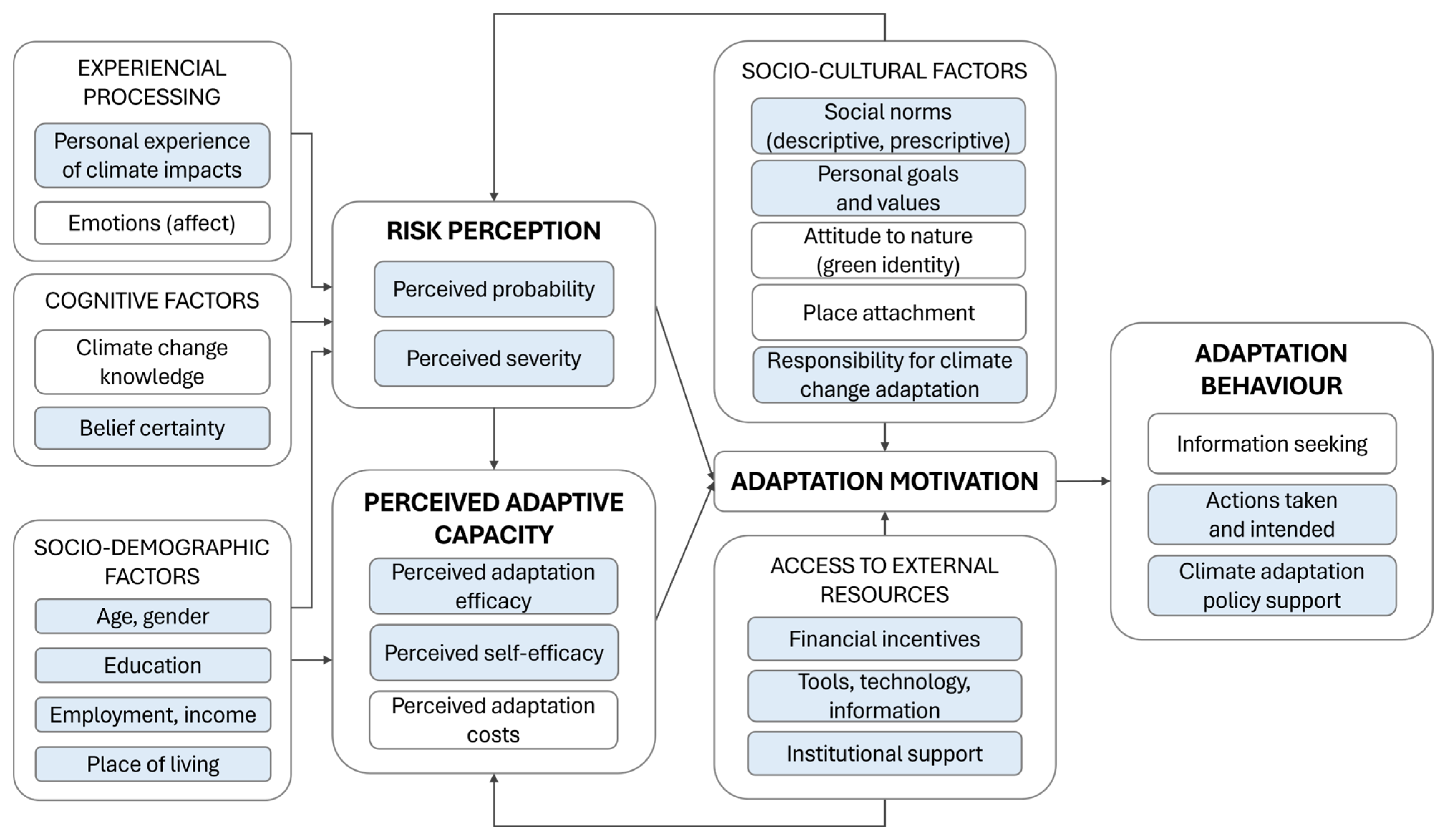

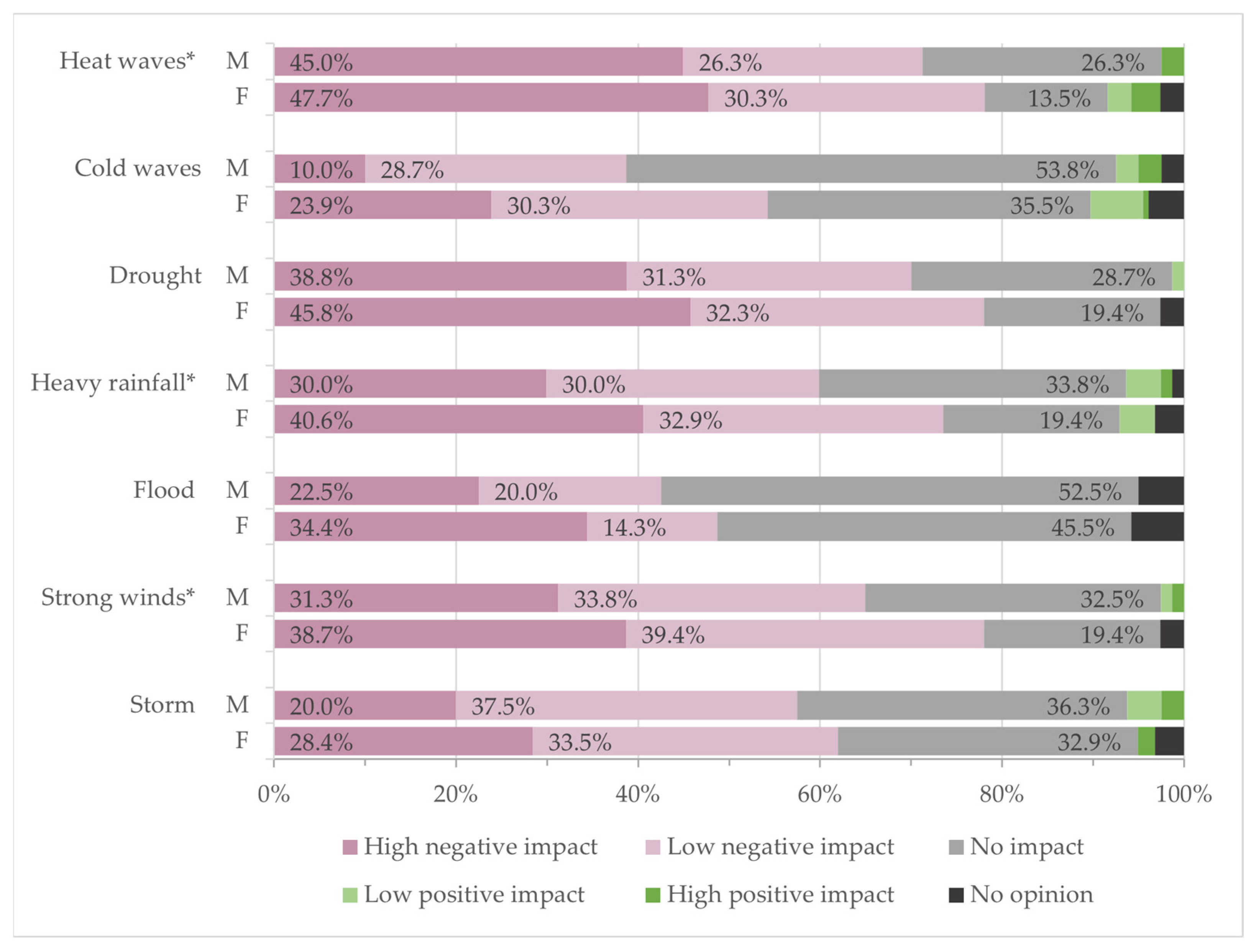
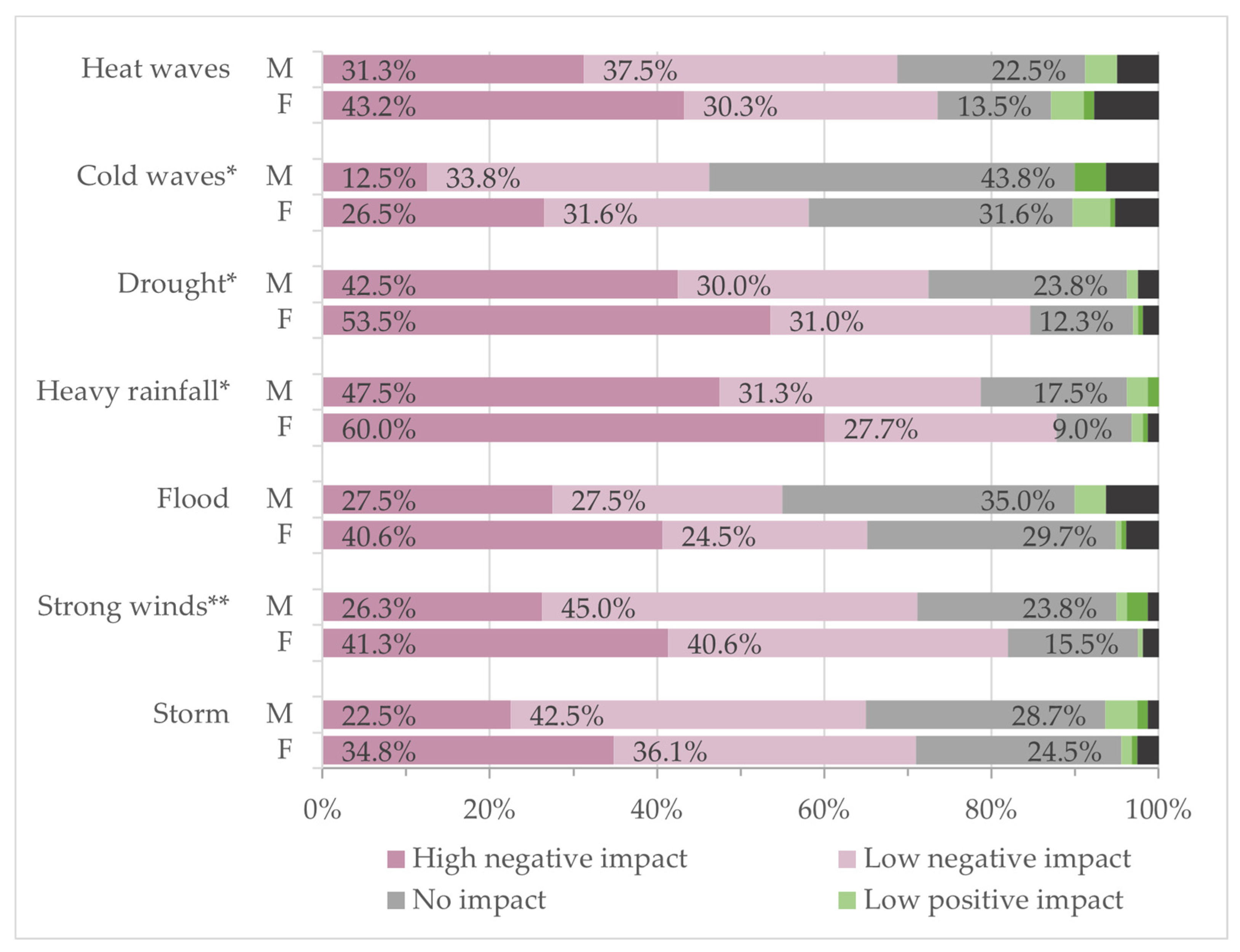
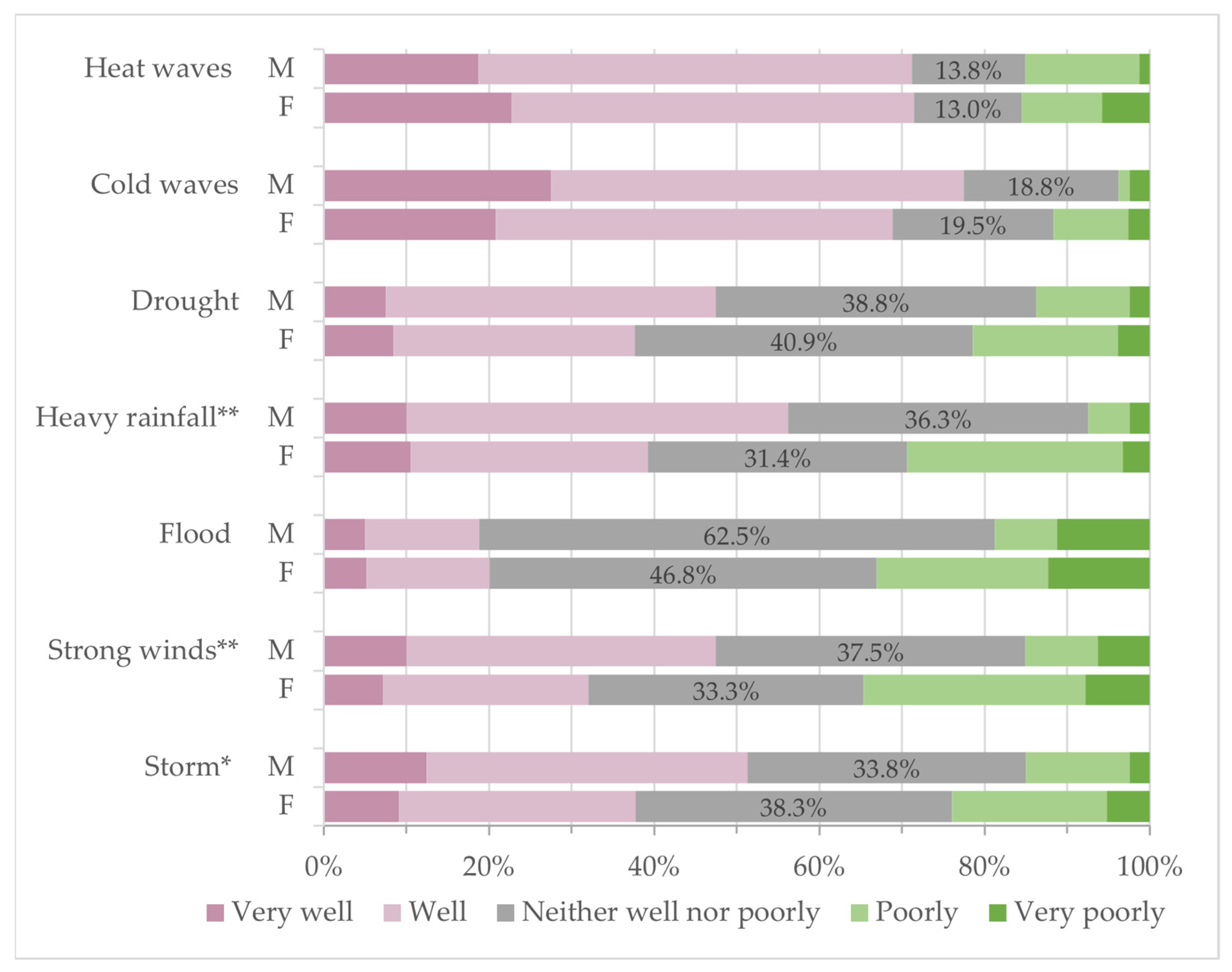
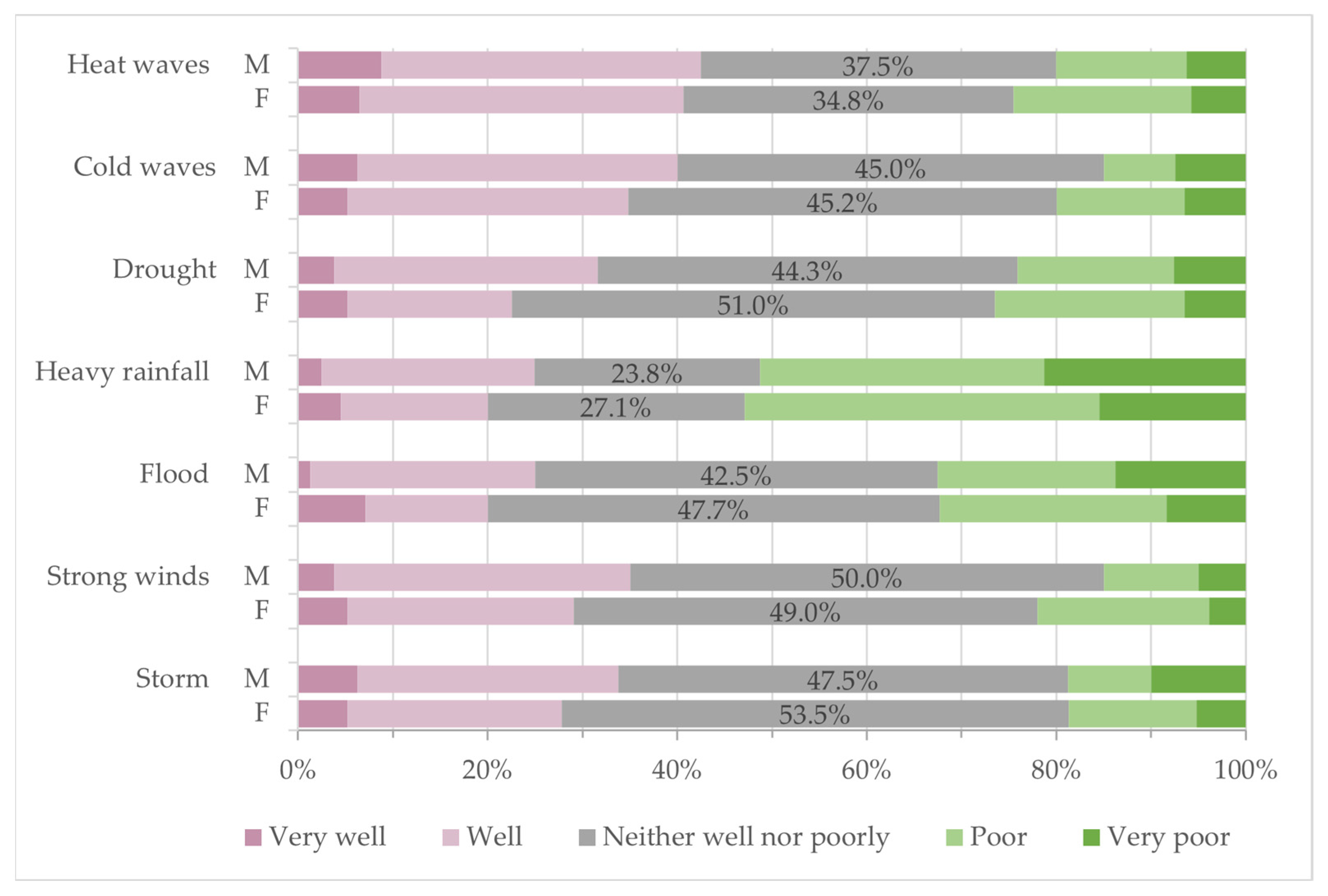
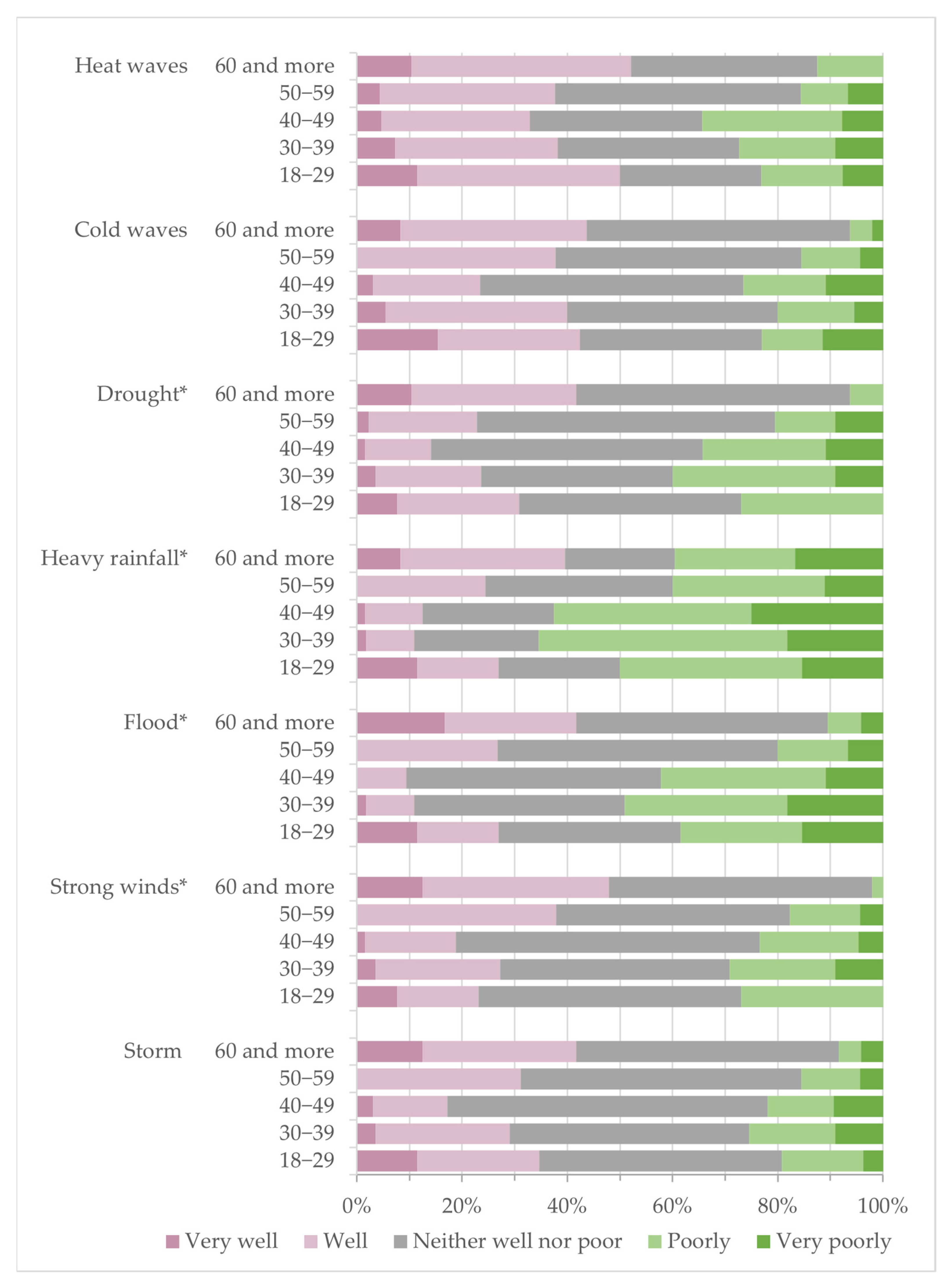
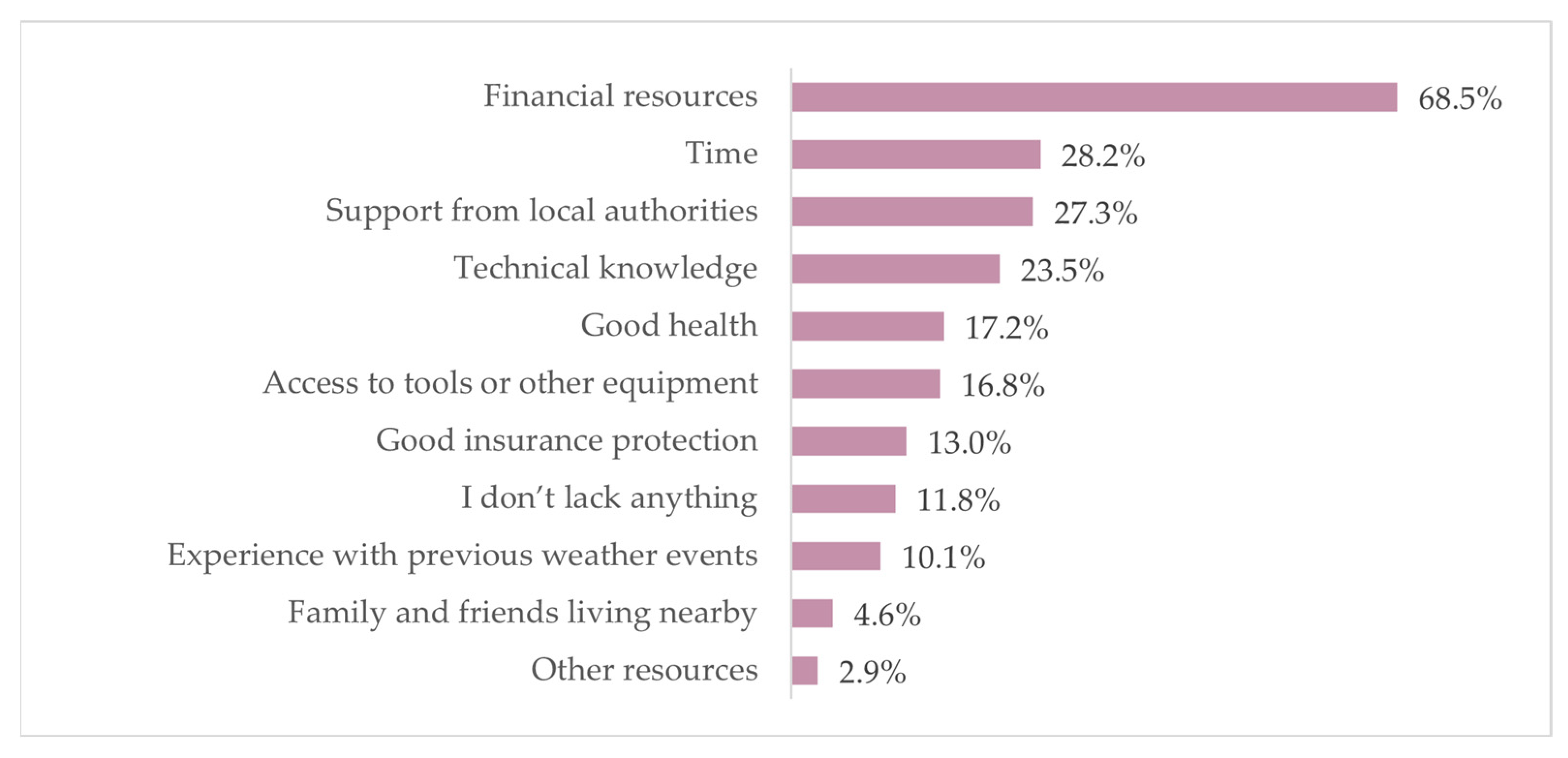
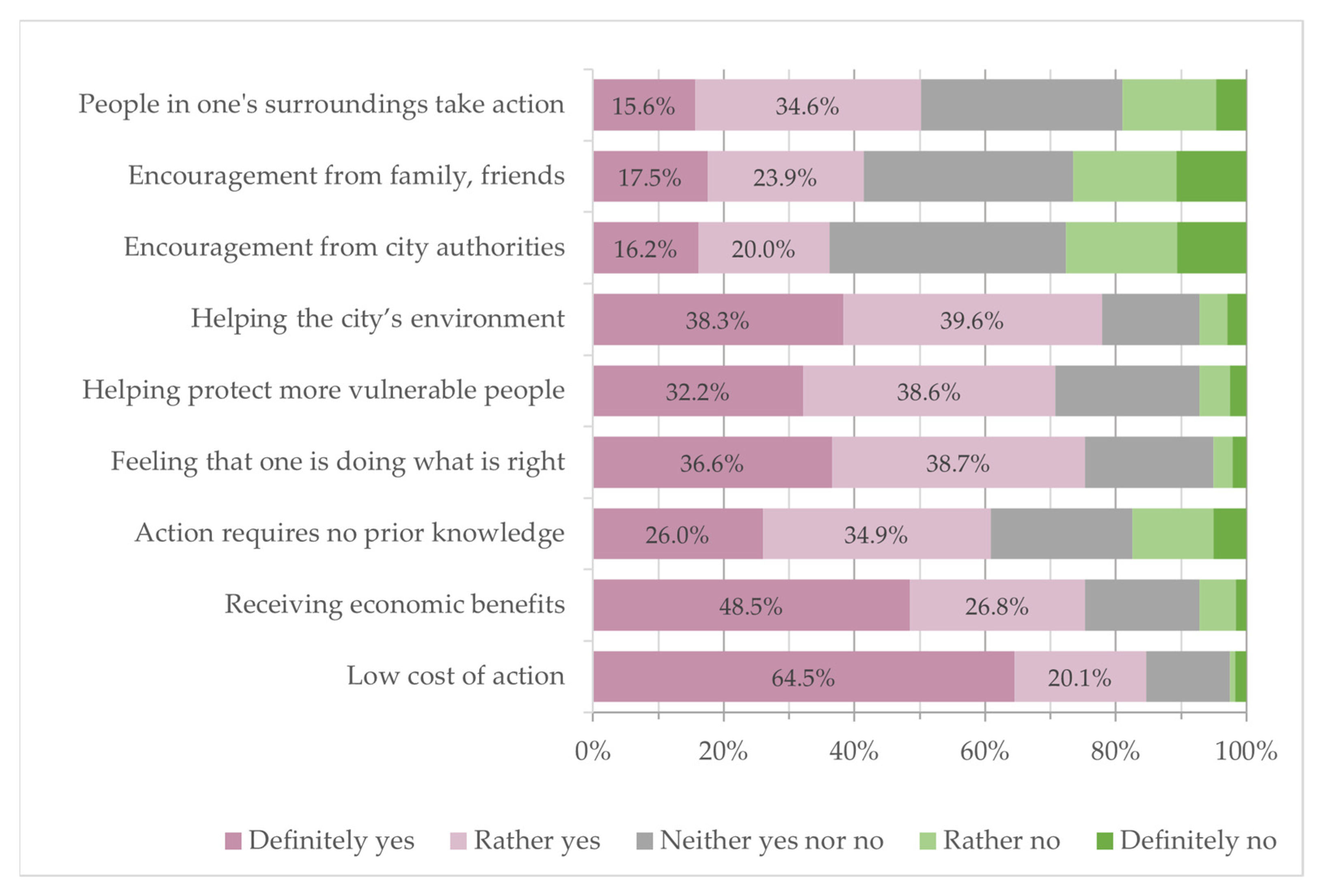
| Reference | Aims and Scope | Methodology | Study Area/Hazard Analysed |
|---|---|---|---|
| [31] | Investigate homeowners’ preparedness for climate change impacts (interest in purchasing mitigation and adaptation improvements), their concern about cli-mate change, awareness of flood risk, and views on responsibility for action. Explain reasons for the low uptake of measures and recommend how to accelerate property-level investment | Survey (telephone) Sample: n = 961 | England and Wales, the UK Hazard: flood |
| [32] | Provide empirical evidence on what inspires adaptation engagement in different citizen groups, including material and subjective aspects (emotions, values, beliefs) | Survey (written) Sample: n = 217 (non-representative) | Lomma, Sweden Hazards: pluvial and coastal flooding, storms |
| [43] | Develop and test a model of antecedents of pro-environmental behaviours (PEB) and their psychological precursors (risk perception, response efficacy, psychological adaptation), validate the model in two national samples, and recommend strategies for promoting behaviour change | Survey (online) Sample: Study 1: n = 3096, Study 2: n = 3480 (nationally representative panels) | Study 1: Australia, Study 2: France Hazards: Storms, Bushfires, Droughts, Floods, and other natural disasters |
| [45] | Deepen the understanding of urban residents’ behavioural response to climate change and its influencing factors | Survey (online) and face-to-face interviews Sample: n = 386 | Tianjin, China Hazard: flood, heat wave, cold spell |
| [47] | Understand the level of, and explanatory factors for, self-protective behaviour of private households against the impacts of extreme weather events | Face-to-face interviews Sample: n = 210 (non-representative) | Three cities in the Philippines Hazards: heat waves, drought, heavy precipitation |
| [48] | Explore whether people’s perceptions of climate change (its reality, causes, and consequences) determine their adaptation actions, i.e., support for policies, information-seeking, and practical preparedness in response to different hazards and contexts | Survey (online) Sample: Study 1: n = 3546 Study 2: n = 803 | Study 1: A medium-sized city in the Netherlands Hazard: pluvial flooding and urban heat island Study 2: The UK Hazard: heatwaves |
| Variable | Factor | Item | References |
|---|---|---|---|
| A. Risk perception of climate change | Perceived probability | Q1. Perceived past weather trends in the city (changes in extreme weather occurrence) | [47] * |
| Belief certainty | Q2. Belief that climate change affects the residents personally | [51] | |
| Perceived severity of impacts | Q3. Extreme weather impact on citizens’ lives | [47] * | |
| Q4. Extreme weather’s impact on the city’s functioning | [47] * | ||
| Personal experience | Q5. Experienced damage due to extreme weather | [32] * | |
| B. Perceived adaptive capacity | Adaptation efficacy | Q8. Belief that adaptation to climate change can help better cope with extreme weather impacts | [43] * |
| Adaptation knowledge | Q12. Belief in being well-informed about methods of coping with climate change | [47] * | |
| Self-efficacy | Q15. Self-assessment of abilities to cope with extreme weather | [32] | |
| Institutional efficacy | Q16. Assessment of the city authorities’ abilities to cope with extreme weather | Own elaboration | |
| C. Adaptation motivation | Social norms and access to resources | Q13. Resources needed to better cope with extreme weather | [32] * |
| Q14. Factors motivating adaptation behaviours of individuals | [32] * | ||
| Adaptation responsibility | Q6. Belief in self-responsibility for property protection against extreme weather | [47] * | |
| Q7. Belief in the city authorities’ responsibility for residents and property protection against extreme weather | [31] * | ||
| D. Adaptation behaviour | Adaptive actions taken and intended | Q9. Adaptation measures to reduce the negative effects of heat waves | [48] * |
| Q10. Adaptation measures to reduce flash floods, urban heat island | [32,48] * | ||
| Q11. Adaptation measures to protect from heavy rainfall, floods, strong winds and storms | [32] | ||
| Grassroot initiatives | Q17. Membership in an NGO or a local association which tries to influence local climate change adaptation policy | [32] * | |
| Q18. Active participation in an association or a residents’ group that seeks to improve the climate and natural environment in the city | [32] * | ||
| Adaptation policy support | Q19. Support for implementing adaptation measures by local authorities to reduce the negative effects of climate change | [48] * |
| Variable | Value | Sample | Variable | Value | Sample | ||
|---|---|---|---|---|---|---|---|
| Gender | Female | 155 | 65.1% | Place of living | Multi-family housing | 114 | 47.7% |
| Male | 80 | 33.6% | Single-family housing | 124 | 51.9% | ||
| Other | 3 | 1.3% | Net income per person in the household | ≤1000 PLN | 4 | 1.7% | |
| Age | 18 to 29 | 26 | 10.9% | 1001–2000 PLN | 48 | 20.2% | |
| 30 to 39 | 55 | 23.1% | 2001–3000 PLN | 74 | 31.1% | ||
| 40 to 49 | 64 | 26.9% | 3001–4000 PLN | 44 | 18.5% | ||
| 50 to 59 | 45 | 18.9% | 4001–5000 PLN | 17 | 7.1% | ||
| >60 | 48 | 20.2% | >5000 PLN | 16 | 6.7% | ||
| Education level | Basic or basic vocational education | 9 | 3.8% | Non-response | 35 | 14.7% | |
| High School Diploma | 68 | 28.2% | Economic activity | Economically active | 180 | 75.3% | |
| University degree | 161 | 68.0% | Economically inactive or unemployed | 58 | 24.3% | ||
| Variable | A. | B. | C. | D. | ||||||||||||||||
|---|---|---|---|---|---|---|---|---|---|---|---|---|---|---|---|---|---|---|---|---|
| Item | Q2. | Q5. | Q8. | Q15. | Q16. | Q6. | Q7. | Q13.1 | Q13.2 | Q13.3 | Q13.4 | Q13.5 | Q13.6 | Q13.7 | Q13.8 | Q13.9 | Q13.10 | Q9–11 (1) | Q9–11 (2) | |
| A | Q2. | 1 | 0.27 * | 0.36 * | −0.25 * | −0.09 | 0.04 | 0.22 * | 0.1 | 0.01 | −0.02 | 0.11 | 0 | 0.02 | −0.05 | 0.15 * | 0.04 | −0.12 | 0.08 | 0.20 * |
| Q5. | 0.27 * | 1 | 0.25 * | −0.19 * | −0.13 * | 0.06 | 0.11 | 0.19 * | −0.06 | 0.01 | −0.01 | −0.06 | 0.15 * | −0.15 * | 0.17 * | 0.18 * | −0.19 * | 0.17 * | 0.16 * | |
| B | Q8. | 0.36 * | 0.25 * | 1 | −0.04 | 0.05 | 0.16 * | 0.34 * | 0.07 | 0 | 0.16 * | 0.11 | 0.02 | −0.07 | −0.05 | 0.09 | 0 | −0.15 * | 0.19 * | 0.06 |
| Q15. | −0.25 * | −0.19 * | −0.04 | 1 | 0.32 * | 0.11 | −0.08 | −0.06 | −0.01 | 0.02 | −0.15 * | −0.07 | −0.08 | −0.18 * | −0.16 * | −0.08 | 0.13 * | 0.15 * | −0.21 * | |
| Q16. | −0.09 | −0.13 * | 0.05 | 0.32 * | 1 | 0.19 * | −0.21 * | −0.17 * | −0.02 | 0.02 | 0 | 0.09 | −0.04 | 0 | −0.18 * | −0.34 * | 0.16 * | −0.05 | −0.02 | |
| C | Q6. | 0.04 | 0.06 | 0.16 * | 0.11 | 0.19 * | 1 | −0.03 | 0 | −0.04 | 0.1 | 0 | −0.08 | 0.01 | −0.12 | 0.09 | −0.14 * | −0.01 | 0.08 | 0.02 |
| Q7. | 0.22 * | 0.11 | 0.34 * | −0.08 | −0.21 * | −0.03 | 1 | 0.11 | 0 | −0.08 | 0.02 | 0 | −0.09 | −0.1 | −0.01 | 0.15 * | −0.08 | 0.02 | 0.13 | |
| Q13.1 | 0.1 | 0.19 * | 0.07 | −0.06 | −0.17 * | 0 | 0.11 | 1 | 0.11 | −0.06 | −0.02 | −0.05 | 0.06 | −0.07 | 0.1 | 0.09 | −0.53 * | 0.07 | 0.24 * | |
| Q13.2 | 0.01 | −0.06 | 0 | −0.01 | −0.02 | −0.04 | 0 | 0.11 | 1 | −0.07 | −0.05 | −0.15 * | −0.08 | 0.04 | 0.12 | 0 | −0.16 * | 0.01 | 0.17 * | |
| Q13.3 | −0.02 | 0.01 | 0.16 * | 0.02 | 0.02 | 0.1 | −0.08 | −0.06 | −0.07 | 1 | 0.03 | −0.01 | −0.05 | −0.05 | −0.04 | 0.04 | −0.14 * | −0.05 | 0.05 | |
| Q13.4 | 0.11 | −0.01 | 0.11 | −0.15 * | 0 | 0 | 0.02 | −0.02 | −0.05 | 0.03 | 1 | 0.11 | −0.14 * | −0.01 | −0.07 | 0.04 | −0.08 | −0.12 | 0.05 | |
| Q13.5 | 0 | −0.06 | 0.02 | −0.07 | 0.09 | −0.08 | 0 | −0.05 | −0.15 * | −0.01 | 0.11 | 1 | −0.01 | 0.11 | −0.1 | −0.13 * | −0.16 * | −0.09 | −0.02 | |
| Q13.6 | 0.02 | 0.15 * | −0.07 | −0.08 | −0.04 | 0.01 | −0.09 | 0.06 | −0.08 | −0.05 | −0.14 * | −0.01 | 1 | −0.05 | −0.02 | −0.03 | −0.22 * | 0.08 | 0.09 | |
| Q13.7 | −0.05 | −0.15 * | −0.05 | −0.18 * | 0 | −0.12 | −0.1 | −0.07 | 0.04 | −0.05 | −0.01 | 0.11 | −0.05 | 1 | 0.04 | −0.02 | −0.12 | −0.05 | 0.07 | |
| Q13.8 | 0.15 * | 0.17 * | 0.09 | −0.16 * | −0.18 * | 0.09 | −0.01 | 0.1 | 0.12 | −0.04 | −0.07 | −0.1 | −0.02 | 0.04 | 1 | 0.02 | −0.20 * | 0.06 | 0.07 | |
| Q13.9 | 0.04 | 0.18 * | 0 | −0.08 | −0.34 * | −0.14 * | 0.15 * | 0.09 | 0 | 0.04 | 0.04 | −0.13 * | −0.03 | −0.02 | 0.02 | 1 | −0.22 * | 0.07 | 0.12 | |
| Q13.10 | −0.12 | −0.19 * | −0.15 * | 0.13 * | 0.16 * | −0.01 | −0.08 | −0.53 * | −0.16 * | −0.14 * | −0.08 | −0.16 * | −0.22 * | −0.12 | −0.20 * | −0.22 * | 1 | −0.08 | −0.20 * | |
| D | Q9–11 (1) | 0.08 | 0.17 * | 0.19 * | 0.15 * | −0.05 | 0.08 | 0.02 | 0.07 | 0.01 | −0.05 | −0.12 | −0.09 | 0.08 | −0.05 | 0.06 | 0.07 | −0.08 | 1 | −0.33 * |
| Q9–11 (2) | 0.20 * | 0.16 * | 0.06 | −0.21 * | −0.02 | 0.02 | 0.13 | 0.24 * | 0.17 * | 0.05 | 0.05 | −0.02 | 0.09 | 0.07 | 0.07 | 0.12 | −0.20 * | −0.33 * | 1 | |
| Q5. Experienced Damage due to Extreme Weather | |
|---|---|
| Q14. Factors Motivating Adaptation Behaviours of Individuals | R |
| 1. Low cost of action | 0.17 * |
| 2. Receiving economic benefits (e.g., tax reduction) | 0.19 * |
| 3. Encouragement from family, friends or neighbours | 0.25 * |
| 4. Helping protect more vulnerable people | 0.24 * |
| 5. Clear conscience that one does what is “right” | 0.22 * |
| 6. People in the surroundings take action | 0.25 * |
| 7. Contributing to the quality of the city’s environment | 0.36 * |
| 8. Action requires low or no prior knowledge | 0.12 |
| 9. Encouragement from city authorities | 0.05 |
Disclaimer/Publisher’s Note: The statements, opinions and data contained in all publications are solely those of the individual author(s) and contributor(s) and not of MDPI and/or the editor(s). MDPI and/or the editor(s) disclaim responsibility for any injury to people or property resulting from any ideas, methods, instructions or products referred to in the content. |
© 2025 by the authors. Licensee MDPI, Basel, Switzerland. This article is an open access article distributed under the terms and conditions of the Creative Commons Attribution (CC BY) license (https://creativecommons.org/licenses/by/4.0/).
Share and Cite
Piotrkowska, M.; Rędzińska, K.; Zgutka, M.; Płaszczyca, M. Driving Sustainable Adaptation Through Community Engagement: A Social Adaptive Capacity Tool for Climate Policy. Sustainability 2025, 17, 9361. https://doi.org/10.3390/su17219361
Piotrkowska M, Rędzińska K, Zgutka M, Płaszczyca M. Driving Sustainable Adaptation Through Community Engagement: A Social Adaptive Capacity Tool for Climate Policy. Sustainability. 2025; 17(21):9361. https://doi.org/10.3390/su17219361
Chicago/Turabian StylePiotrkowska, Monika, Katarzyna Rędzińska, Monika Zgutka, and Małgorzata Płaszczyca. 2025. "Driving Sustainable Adaptation Through Community Engagement: A Social Adaptive Capacity Tool for Climate Policy" Sustainability 17, no. 21: 9361. https://doi.org/10.3390/su17219361
APA StylePiotrkowska, M., Rędzińska, K., Zgutka, M., & Płaszczyca, M. (2025). Driving Sustainable Adaptation Through Community Engagement: A Social Adaptive Capacity Tool for Climate Policy. Sustainability, 17(21), 9361. https://doi.org/10.3390/su17219361






